Force and Microstructure Variation of SLM Prepared AlMgSc Samples during Three-Point Bending
Abstract
:1. Introduction
2. Experimental Methods
2.1. Material and Structural Dimensions
2.2. Three Point Bending
2.3. Fracture Analysis
2.4. EBSD Testing
3. Analysis of Experimental Results
3.1. Bending Fracture Analysis
3.2. Analysis of Bending Curves
- (1)
- The curve trend is continuous without a step before total fracture, although the struts are broken successively during bending. The grid struts are brittle based on the morphology analysis of the cross section, and the “stress step” should appear at the moment, yet the curve is continuous here. This phenomenon may be attributed to two causes: the first is the inhomogeneous fracture as presented above, and the second is local plastic deformation, which could be confirmed by the tensile band in the fracture plane (Figure 6c).
- (2)
- The sudden drop of the curve appears uniformly in the fracture of the upper end plate, which appears in the late stages of the entire deformation process. There is no reduction in deformation resistance, although the successive brittle fracture of grid struts during bending is observed. The sandwich structure is advantageous in such deformation modes. Even if the material is brittle, there will be no sudden drop of bending resistance before the fracture of the upper end plate.
- (3)
- As illustrated in Figure 5h, the elongation and strength of 45° oriented struts are the lowest in three-point bending, while the differences between those of 30° and 60° struts are little. The cause is that the stress state of the 45-degree oriented strut is the most prone to shear deformation [32].
3.3. Equivalent Bending Stress Calculation
3.4. Microstructure Analysis
4. Conclusions
- The samples mainly fracture in a brittle manner during bending, and the force varies continuously with displacement. The causes include the inhomogeneous breakage of the struts in the grid layer and the plastic deformation realized by grain crushing and rotation in bending.
- The change rate of stress in three-point bending of the samples demonstrates three characteristic stages: in the first stage, the change rate increases with displacement due to rigid movement; the change rate in the second stage remains constant, which denotes elastic deformation; and in the third stage, the change rate decreases with an increase in displacement, which includes plastic deformation.
- The calculation method of equivalent bending stress in free bending is not applicable to sandwich structure samples when compactability is below 67% due to heavy deviation to ideal assumptions.
- The heat generated by the late-forming layer causes recrystallization of the early forming layer; the grain size becomes larger in the equiaxed grain region, and [101] crystal orientation is distributed perpendicularly to the scanning direction.
- The (001) texture of the bent upper end plate on width direction is stronger than that of the lower one, which may be due to the compression–tension deformation mode.
Author Contributions
Funding
Institutional Review Board Statement
Informed Consent Statement
Data Availability Statement
Conflicts of Interest
References
- Mohsenizadeh, M.; Gasbarri, F.; Munther, M.; Beheshti, A.; Davami, K. Additively-manufactured lightweight Metamaterials for energy absorption. Mater. Des. 2018, 139, 521–530. [Google Scholar] [CrossRef]
- Maconachie, T.; Leary, M.; Lozanovski, B.; Zhang, X.; Brandt, M. SLM lattice structures: Properties, performance, applications and challenges. Mater. Des. 2019, 183, 108–137. [Google Scholar] [CrossRef]
- Shi, C.; Han, M.; Zhang, K.; Lu, Z. Effects of Sintering Temperature on Microstructure Evolution and Hot Deformation Behavior of TiAl-Based Alloys Prepared by Spark Plasma Sintering. JOM 2018, 70, 2739–2745. [Google Scholar] [CrossRef]
- Ai, C.; Liu, L.; Goh, J.C.-H. Pore size modulates in vitro osteogenesis of bone marrow mesenchymal stem cells in fibronectin/gelatin coated silk fibroin scaffolds. Mater. Sci. Eng. C 2021, 124, 112088. [Google Scholar] [CrossRef]
- Nickels, L. AM and aerospace: An ideal combination. Met. Powder Rep. 2015, 70, 300–303. [Google Scholar] [CrossRef]
- Blakey-Milner, B.; Gradl, P.; Snedden, G.; Brooks, M.; Pitot, J.; Lopez, E.; Leary, M.; Berto, F.; du Plessis, A. Metal additive manufacturing in aerospace: A review. Mater. Des. 2021, 209, 110008. [Google Scholar] [CrossRef]
- Yan, X.; Li, Q.; Yin, S.; Chen, Z.; Jenkins, R.; Chen, C.; Wang, J.; Ma, W.; Bolot, R.; Lupoi, R.; et al. Mechanical and in vitro study of an isotropic Ti6Al4V lattice structure fabricated using selective laser melting. J. Alloys Compd. 2019, 782, 209–223. [Google Scholar] [CrossRef]
- Yandong, Y.; Shuzhen, K.; Jie, L. Influence of Applied Voltage and Film-Formation Time on Microstructure and Corrosion Resistance of Coatings Formed on Mg-Zn-Zr-Ca Bio-magnesium Alloy. JOM 2015, 67, 2133–2144. [Google Scholar] [CrossRef]
- Xiao, H.; Jiang, S.; Shi, C.; Zhang, K.; Lu, Z.; Jiang, J. Study on the microstructure evolution and mechanical properties of an Al-Mg-Li alloy aged by electropulsing assisted ageing processing. Mater. Sci. Eng. A 2019, 756, 442–454. [Google Scholar] [CrossRef]
- Yang, Q.Y.; Zhou, Y.L.; Tan, Y.B.; Xiang, S.; Ma, M.; Zhao, F. Effects of microstructure, texture evolution and strengthening mechanisms on mechanical properties of 3003 aluminum alloy during cryogenic rolling. J. Alloys Compd. 2021, 884, 161135. [Google Scholar] [CrossRef]
- Zhou, B.; Liu, B.; Zhang, S.; Lin, R.; Jiang, Y.; Lan, X. Microstructure evolution of recycled 7075 aluminum alloy and its mechanical and corrosion properties. J. Alloys Compd. 2021, 879, 160407. [Google Scholar] [CrossRef]
- Churyumov, A.Y.; Pozdniakov, A.V.; Prosviryakov, A.S.; Loginova, I.S.; Daubarayte, D.K.; Ryabov, D.K.; Korolev, V.A.; Solonin, A.N.; Pavlov, M.D.; Valchuk, S.V. Microstructure and mechanical properties of a novel selective laser melted Al–Mg alloy with low Sc content. Mater. Res. Express 2019, 6, 126595. [Google Scholar] [CrossRef]
- Rogachev, S.O.; Naumova, E.A.; Lukina, E.A.; Zavodov, A.V.; Khatkevich, V.M. High Strength Al–La, Al–Ce, and Al–Ni Eutectic Aluminum Alloys Obtained by High-Pressure Torsion. Materials 2021, 14, 6404. [Google Scholar] [CrossRef]
- Peng, H.; Hou, Z.; Chen, X.; Li, T.; Luo, J.; Li, X. Effect of temperature and cyclic loading on stress relaxation behavior of Ti–6Al–4V titanium alloy. Mater. Sci. Eng. A 2021, 824, 141789. [Google Scholar] [CrossRef]
- Koutny, D.; Skulina, D.; Pantělejev, L.; Paloušek, D.; Lenczowski, B.; Palm, F.; Nick, A. Processing of Al-Sc aluminum alloy using SLM technology. Procedia CIRP 2018, 74, 44–48. [Google Scholar] [CrossRef]
- Spierings, A.B.; Dawson, K.; Uggowitzer, P.J.; Wegener, K. Influence of SLM scan-speed on microstructure, precipitation of Al3Sc particles and mechanical properties in Sc- and Zr-modified Al-Mg alloys. Mater. Des. 2018, 140, 134–143. [Google Scholar] [CrossRef]
- Spierings, A.B.; Dawson, K.; Kern, K.; Palm, F.; Wegener, K. SLM-processed Sc- and Zr- modified Al-Mg alloy: Mechanical properties and microstructural effects of heat treatment. Mater. Sci. Eng. A 2017, 701, 264–273. [Google Scholar] [CrossRef]
- Yan, X.; Chang, C.; Dong, D.; Gao, S.; Ma, W.; Liu, M.; Liao, H.; Yin, S. Microstructure and mechanical properties of pure copper manufactured by selective laser melting. Mater. Sci. Eng. A 2020, 789, 139615. [Google Scholar] [CrossRef]
- Al-Ketan, O.; Rowshan, R.; Abu Al-Rub, R.K. Topology-mechanical property relationship of 3D printed strut, skeletal, and sheet based periodic metallic cellular materials. Addit. Manuf. 2018, 19, 167–183. [Google Scholar] [CrossRef]
- Korshunova, N.; Alaimo, G.; Hosseini, S.B.; Carraturo, M.; Reali, A.; Niiranen, J.; Auricchio, F.; Rank, E.; Kollmannsberger, S. Bending behavior of octet-truss lattice structures: Modelling options, numerical characterization and experimental validation. Mater. Des. 2021, 205, 109693. [Google Scholar] [CrossRef]
- Li, X.; Wang, G.; Zhang, J.; Liu, Y. Electrically assisted superplastic forming/diffusion bonding of the Ti2AlNb alloy sheet. Int. J. Adv. Manuf. Technol. 2020, 106, 77–89. [Google Scholar] [CrossRef]
- Bayoumy, D.; Schliephake, D.; Dietrich, S.; Wu, X.H.; Zhu, Y.M.; Huang, A.J. Intensive processing optimization for achieving strong and ductile Al-Mn-Mg-Sc-Zr alloy produced by selective laser melting. Mater. Des. 2021, 198, 109317. [Google Scholar] [CrossRef]
- Bian, Y.; Yang, F.; Zhang, S.; Chen, M.; Song, Y. Similarities of the Mechanical Responses of Body-Centered Cubic Lattice Structures with Different Constituent Materials under Compression. JOM 2021. [Google Scholar] [CrossRef]
- Huang, Z.; Zhang, X. Three-point bending collapse of thin-walled rectangular beams. Int. J. Mech. Sci. 2018, 144, 461–479. [Google Scholar] [CrossRef]
- Tian, C.; Li, X.; Li, H.; Guo, G.; Wang, L.; Rong, Y. The effect of porosity on the mechanical property of metal-bonded diamond grinding wheel fabricated by selective laser melting (SLM). Mater. Sci. Eng. A 2019, 743, 697–706. [Google Scholar] [CrossRef]
- Shibkov, A.A.; Zheltov, M.A.; Gasanov, M.F.; Zolotov, A.E.; Denisov, A.A.; Lebyodkin, M.A. Dynamics of deformation band formation investigated by high-speed techniques during creep in an AlMg alloy. Mater. Sci. Eng. A 2020, 772, 138777. [Google Scholar] [CrossRef] [Green Version]
- Yang, D.; An, Y.; Cizek, P.; Hodgson, P. Development of adiabatic shear band in cold-rolled titanium. Mater. Sci. Eng. A 2011, 528, 3990–3997. [Google Scholar] [CrossRef]
- Huang, W.; Chen, X.; Huang, X.; Wang, H.; Zhu, Y. Anisotropic Study of Ti6Al4V Alloy Formed by Selective Laser Melting. JOM 2021, 73, 3804–3811. [Google Scholar] [CrossRef]
- Liu, Z.; Li, X.; Wang, X.; Tian, C.; Wang, L. Comparative investigation on grindability of Inconel 718 made by selective laser melting (SLM) and casting. Int. J. Adv. Manuf. Technol. 2019, 100, 3155–3166. [Google Scholar] [CrossRef]
- Yang, Y.; Gong, Y.; Qu, S.; Yin, G.; Liang, C.; Li, P. Additive and Subtractive Hybrid Manufacturing (ASHM) of 316L Stainless Steel: Single-Track Specimens, Microstructure, and Mechanical Properties. JOM 2021, 73, 759–769. [Google Scholar] [CrossRef]
- Jiang, H.; Wu, Y.; Gong, X.; Shan, D.; Zong, Y. Control of flow lines during the forging process of bearing outer rings with a deviated groove. Int. J. Adv. Manuf. Technol. 2020, 106, 753–764. [Google Scholar] [CrossRef]
- Zhao, J.; Wang, K.; Lv, L.; Liu, G. Evolution and Distribution of Geometrically Necessary Dislocations for TA15 Titanium Alloy Sheets During the Hot Tensile Process. JOM 2019, 71, 2303–2312. [Google Scholar] [CrossRef]
- Peng, H.; Li, M.; Li, Z.; Li, X. Surface quality and shape accuracy of multi-point warm press forming Corian sheets. Int. J. Adv. Manuf. Technol. 2019, 104, 4727–4733. [Google Scholar] [CrossRef]
- Jindra, D.; Kala, Z.; Kala, J.; Seitl, S. Experimental and Numerical simulation of a Three Point Bending Test of a Stainless Steel Beam. Transp. Res. Procedia 2021, 55, 1114–1121. [Google Scholar] [CrossRef]
- Kimura, Y.; Fujak, S.M.; Suzuki, A. Elastic local buckling strength of I-beam cantilevers subjected to bending moment and shear force based on flange–web interaction. Thin Walled Struct. 2021, 162, 107633. [Google Scholar] [CrossRef]
- Montoya-Vargas, S.; Dario Aristizabal-Ochoa, J. Torsion of prismatic I-beams with partially restrained warping at the end supports: Bending analogy method. Eng. Struct. 2019, 180, 621–629. [Google Scholar] [CrossRef]
- Spierings, A.B.; Dawson, K.; Heeling, T.; Uggowitzer, P.J.; Schäublin, R.; Palm, F.; Wegener, K. Microstructural features of Sc- and Zr-modified Al-Mg alloys processed by selective laser melting. Mater. Des. 2017, 115, 52–63. [Google Scholar] [CrossRef]
- Li, Y.; Liu, S.; Xue, T.; Wei, Y.; Yang, X.; Wang, Y. Comparison of wear behavior of GCr15 bearing steel prepared by selective laser melting (SLM) and electron beam melting (EBM). Mater. Lett. 2021, 305, 130726. [Google Scholar] [CrossRef]
- Spierings, A.B.; Dawson, K.; Dumitraschkewitz, P.; Pogatscher, S.; Wegener, K. Microstructure characterization of SLM-processed Al-Mg-Sc-Zr alloy in the heat treated and HIPed condition. Addit. Manuf. 2018, 20, 173–181. [Google Scholar] [CrossRef]
- Ma, R.; Peng, C.; Cai, Z.; Wang, R.; Zhou, Z.; Li, X.; Cao, X. Enhanced strength of the selective laser melted Al-Mg-Sc-Zr alloy by cold rolling. Mater. Sci. Eng. A 2020, 775, 138975. [Google Scholar] [CrossRef]
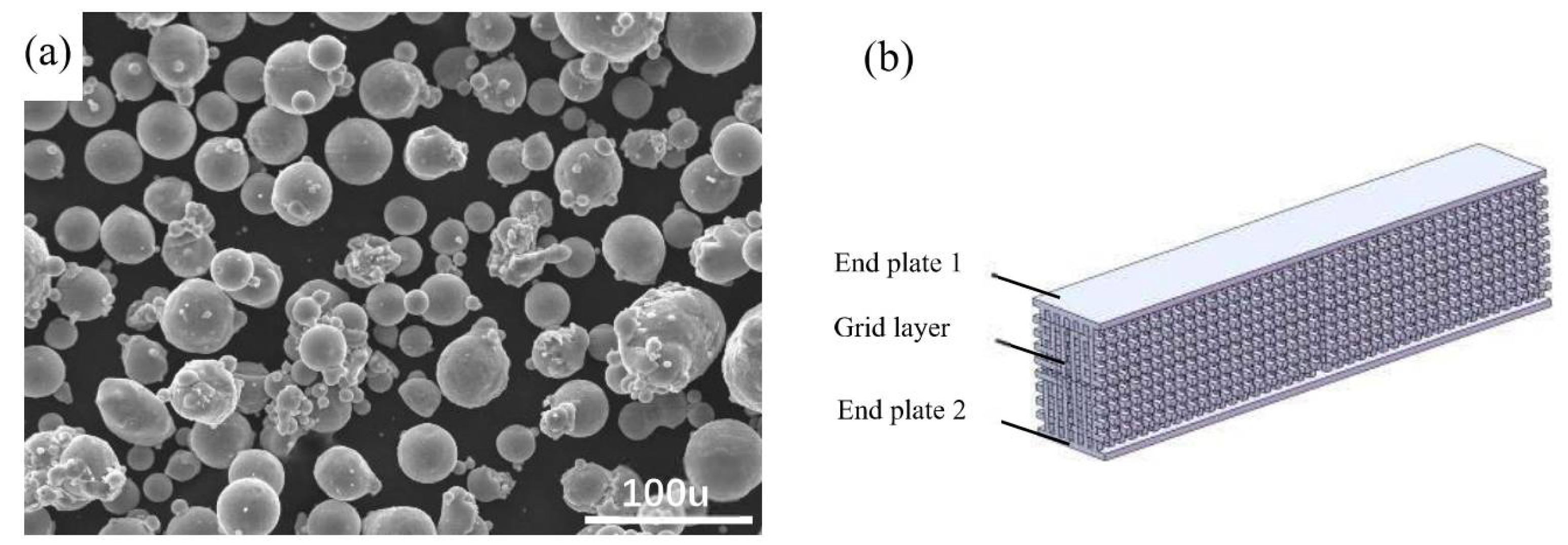
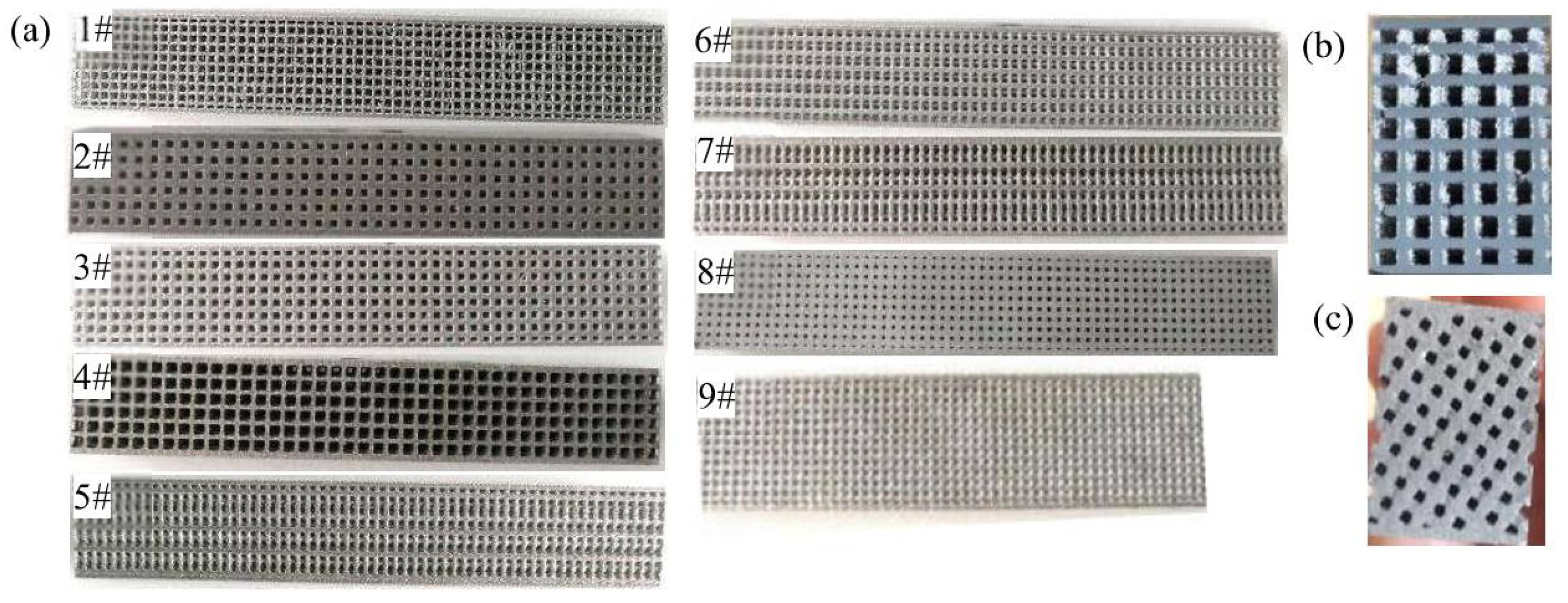
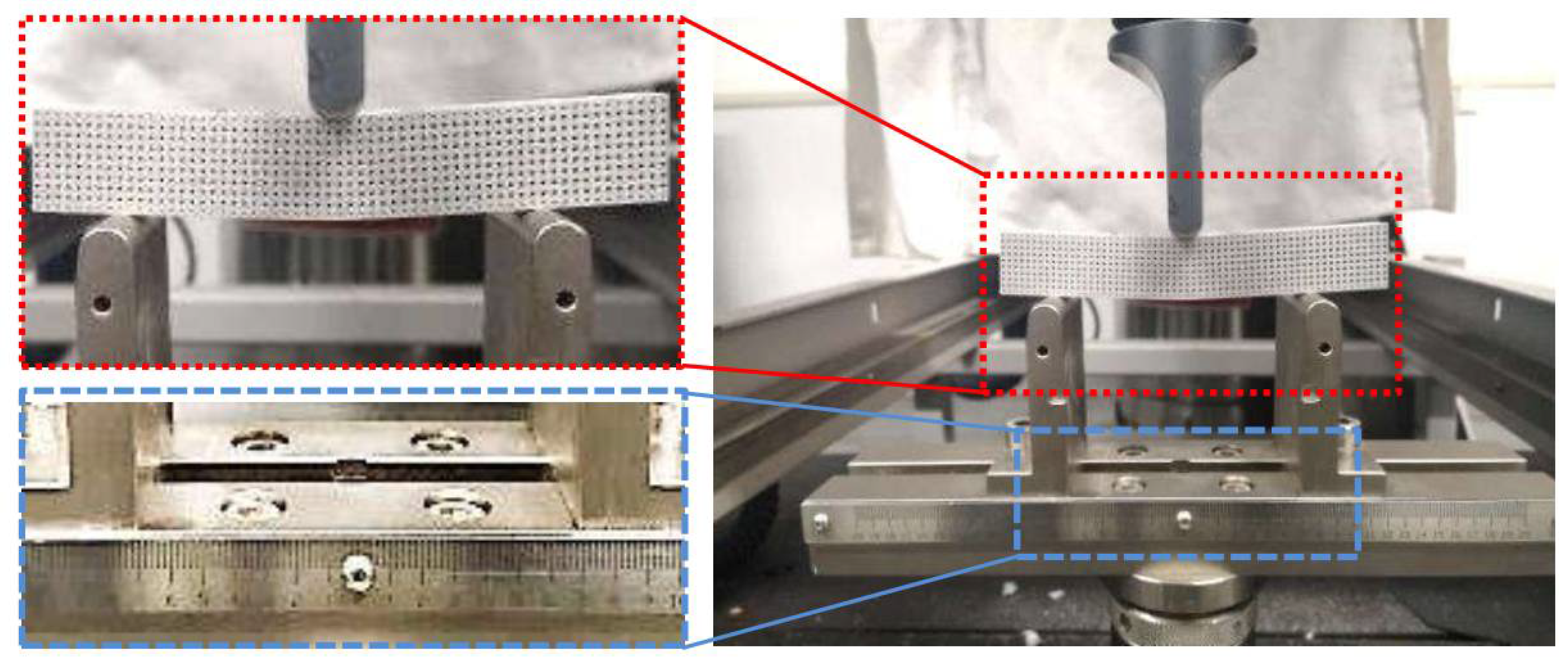

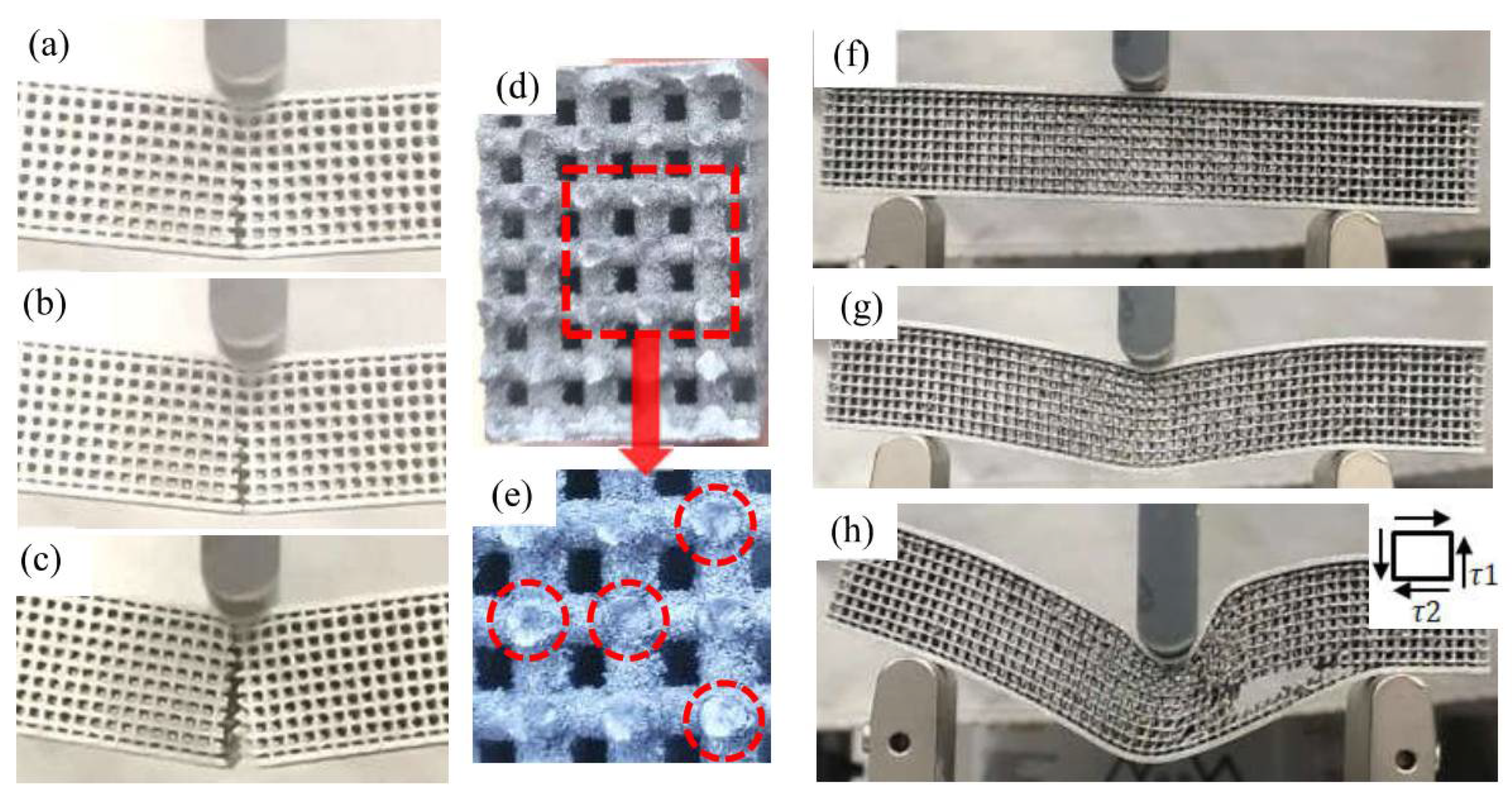
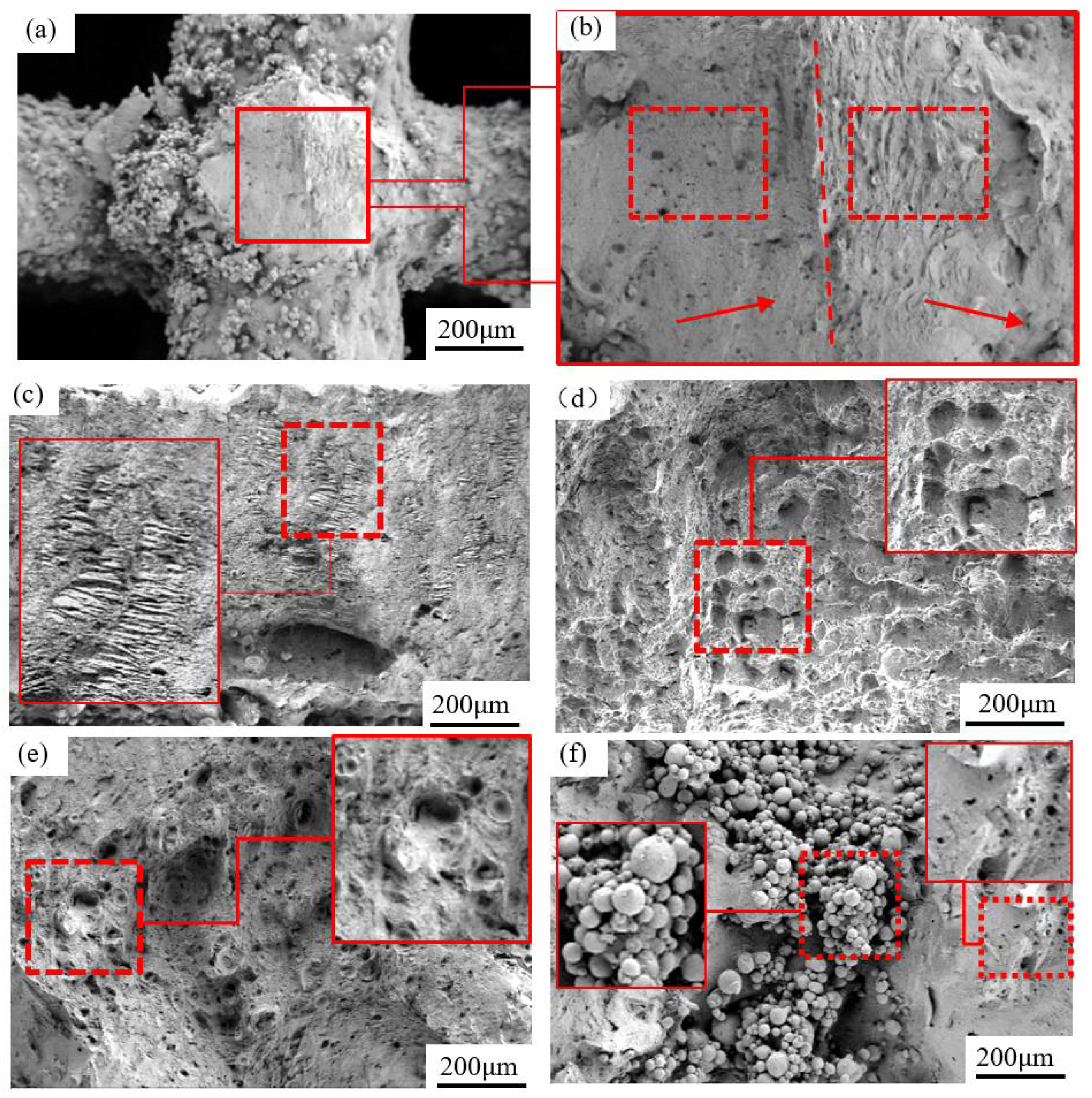
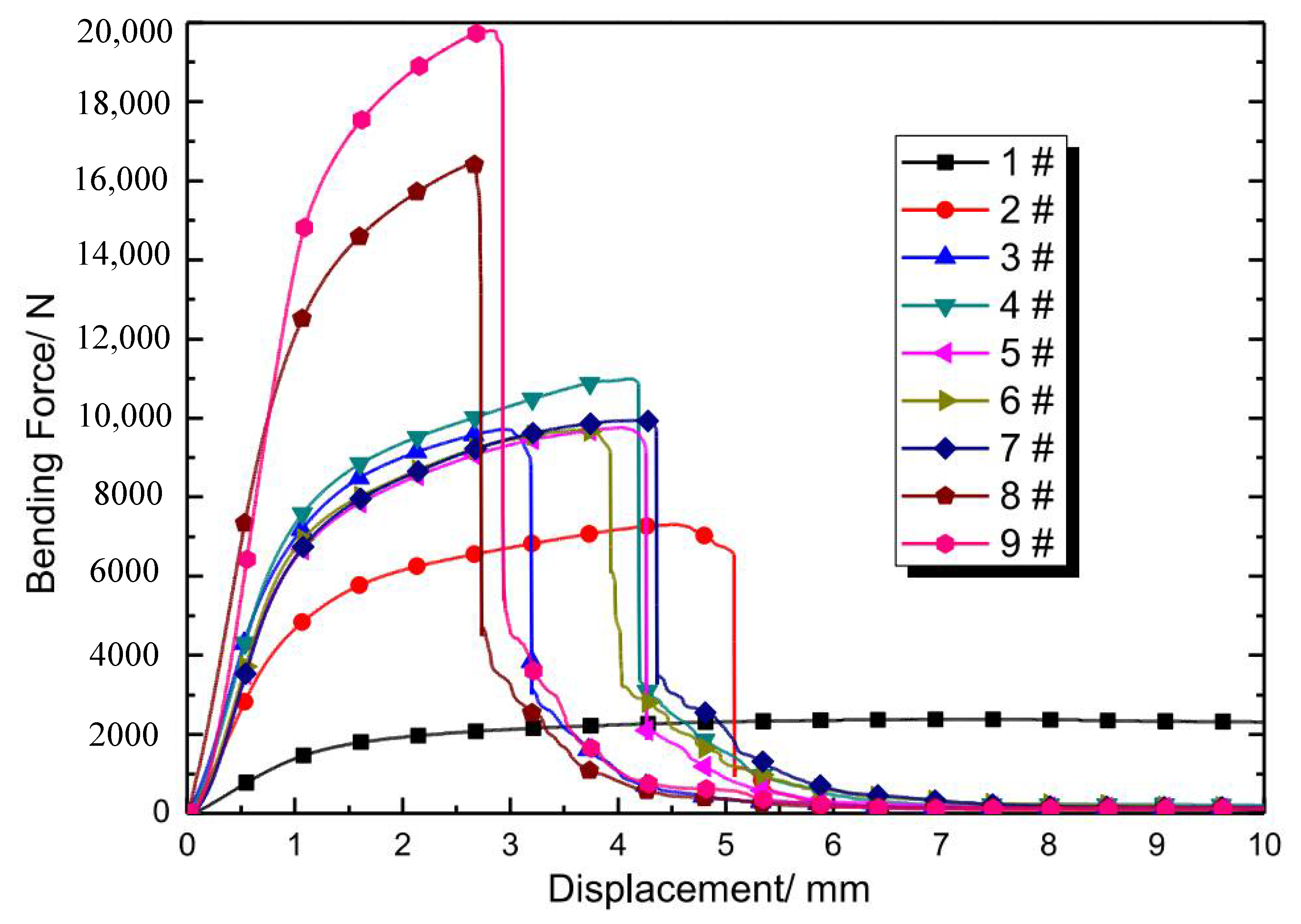
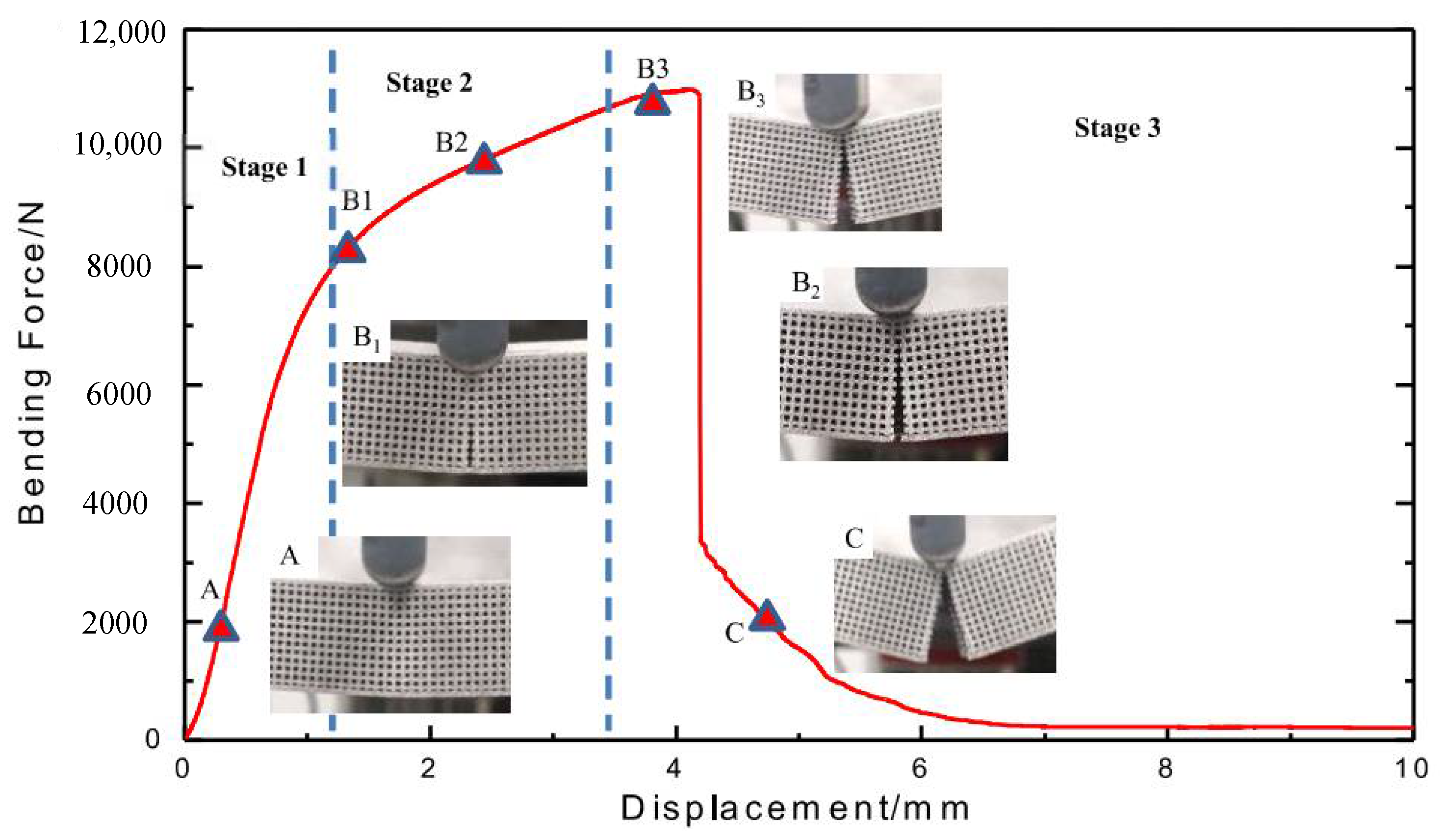
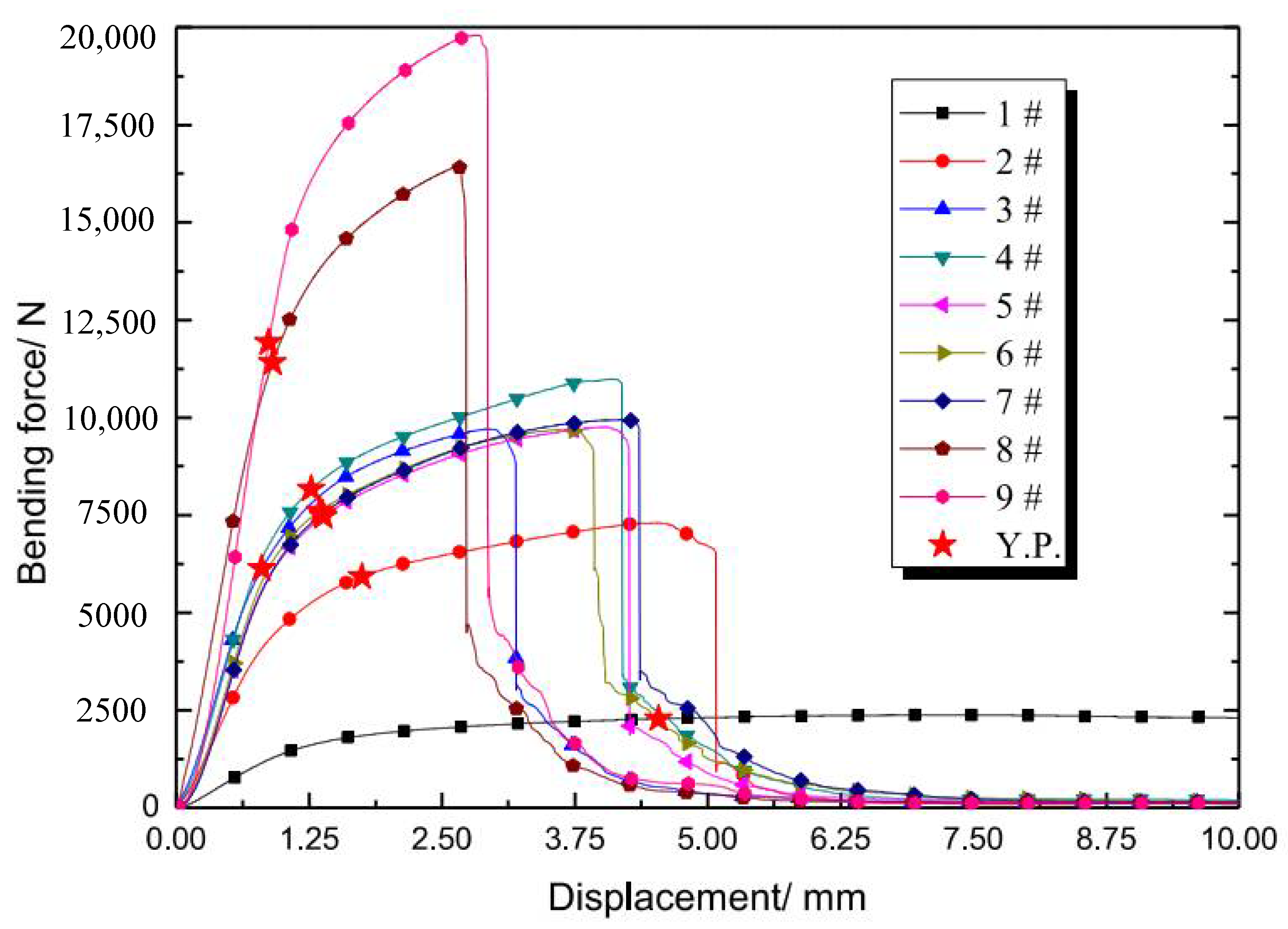




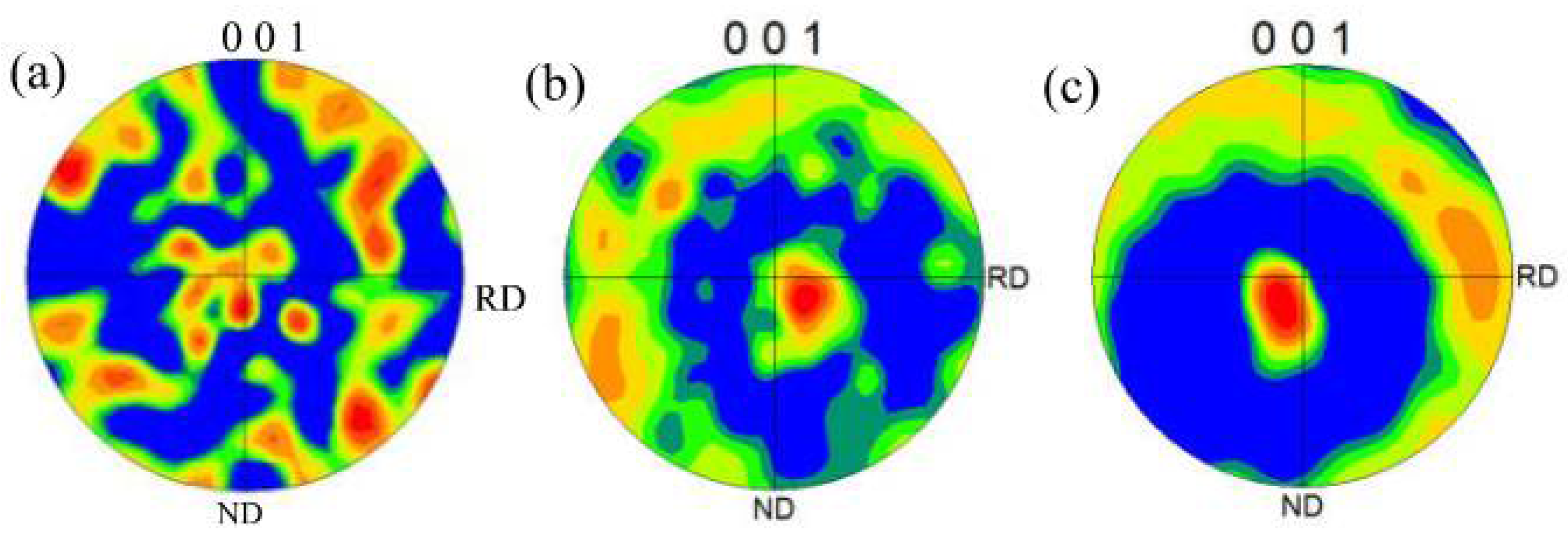
| Number | Unit Length (mm) | Strut Diameter (mm) | Compactability | Inclination (Degree) |
|---|---|---|---|---|
| 1# | 2 | 0.5 | 0.25 | 0 |
| 2# | 2.5 | 1 | 0.4 | 0 |
| 3# | 2 | 1 | 0.5 | 0 |
| 4# | 3 | 1.5 | 0.5 | 0 |
| 5# | 2 | 1 | 0.5 | 35 |
| 6# | 2 | 1 | 0.5 | 45 |
| 7# | 2 | 1 | 0.5 | 60 |
| 8# | 1.5 | 1 | 0.67 | 0 |
| 9# | 2 | 1.5 | 0.75 | 0 |
Publisher’s Note: MDPI stays neutral with regard to jurisdictional claims in published maps and institutional affiliations. |
© 2022 by the authors. Licensee MDPI, Basel, Switzerland. This article is an open access article distributed under the terms and conditions of the Creative Commons Attribution (CC BY) license (https://creativecommons.org/licenses/by/4.0/).
Share and Cite
Nie, D.; Du, R.; Zhang, P.; Shen, F.; Gu, J.; Fu, Y. Force and Microstructure Variation of SLM Prepared AlMgSc Samples during Three-Point Bending. Materials 2022, 15, 437. https://doi.org/10.3390/ma15020437
Nie D, Du R, Zhang P, Shen F, Gu J, Fu Y. Force and Microstructure Variation of SLM Prepared AlMgSc Samples during Three-Point Bending. Materials. 2022; 15(2):437. https://doi.org/10.3390/ma15020437
Chicago/Turabian StyleNie, Daming, Ruilong Du, Pu Zhang, Fangyan Shen, Jason Gu, and Yili Fu. 2022. "Force and Microstructure Variation of SLM Prepared AlMgSc Samples during Three-Point Bending" Materials 15, no. 2: 437. https://doi.org/10.3390/ma15020437





